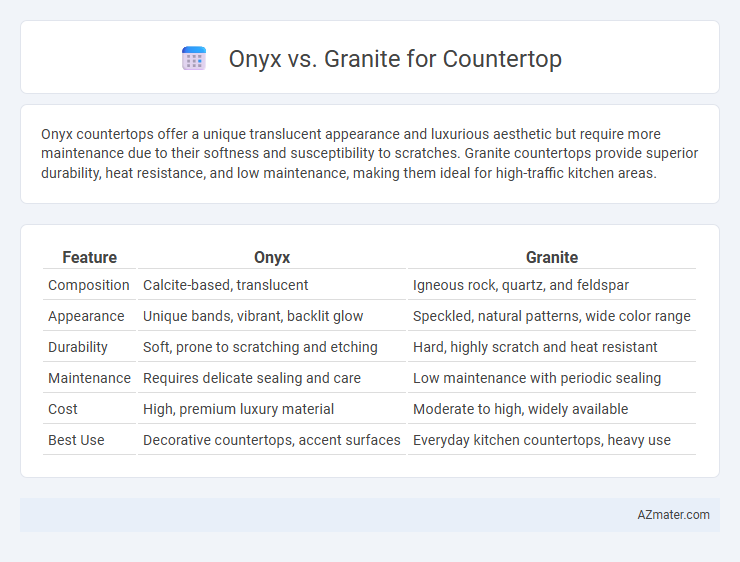Onyx countertops offer a unique translucent appearance and luxurious aesthetic but require more maintenance due to their softness and susceptibility to scratches. Granite countertops provide superior durability, heat resistance, and low maintenance, making them ideal for high-traffic kitchen areas.
Table of Comparison
| Feature | Onyx | Granite |
|---|---|---|
| Composition | Calcite-based, translucent | Igneous rock, quartz, and feldspar |
| Appearance | Unique bands, vibrant, backlit glow | Speckled, natural patterns, wide color range |
| Durability | Soft, prone to scratching and etching | Hard, highly scratch and heat resistant |
| Maintenance | Requires delicate sealing and care | Low maintenance with periodic sealing |
| Cost | High, premium luxury material | Moderate to high, widely available |
| Best Use | Decorative countertops, accent surfaces | Everyday kitchen countertops, heavy use |
Onyx vs Granite: An Overview
Onyx countertops offer a unique translucency and striking patterns that create a luxurious, high-end appearance, but they require more maintenance due to their softness and susceptibility to scratches and etching compared to granite. Granite surfaces provide greater durability, heat resistance, and ease of upkeep, making them a popular choice for busy kitchens and high-traffic areas. While onyx delivers unmatched visual appeal with its glowing, marble-like effect, granite is valued for its long-lasting strength and stain resistance.
Appearance and Aesthetics Comparison
Onyx countertops feature translucent properties that create a striking, luminous effect under lighting, showcasing vivid layers of color often ranging from creamy whites to deep greens and amber tones. Granite offers a more robust, natural stone appearance with a granular texture, displaying a variety of speckled patterns and earth-toned colors such as black, brown, and gray, providing a classic and durable aesthetic. The choice between onyx and granite hinges on the desired visual impact: onyx emphasizes elegance and uniqueness with its glowing translucency, while granite delivers timeless strength and diversity in natural stone patterns.
Durability and Strength Differences
Granite offers superior durability and strength compared to onyx, making it highly resistant to scratches, heat, and everyday wear in kitchen environments. Onyx, while visually stunning with its translucent qualities, is softer and more prone to etching, staining, and chipping under heavy use. Choosing granite ensures long-lasting performance and minimal maintenance, whereas onyx requires delicate care to maintain its aesthetic appeal.
Maintenance and Care Requirements
Onyx countertops demand more delicate maintenance due to their softer, porous nature, requiring regular sealing and immediate cleaning of spills to prevent staining and etching. Granite offers superior durability with less frequent sealing, making it resistant to scratches, heat, and acidic substances, thus simplifying upkeep for high-traffic kitchens. Choosing between onyx and granite hinges on balancing aesthetic preference with a commitment to meticulous care versus practical resilience.
Cost Analysis: Onyx vs Granite
Onyx countertops typically cost between $60 to $125 per square foot, making them significantly more expensive than granite, which ranges from $40 to $100 per square foot. The higher price of onyx is attributed to its rarity, delicate nature, and the extra care required for installation and maintenance. Granite remains a popular cost-effective option due to its durability, wider availability, and lower long-term upkeep expenses.
Installation Complexity and Process
Onyx countertops require meticulous handling during installation due to their fragile and translucent nature, often necessitating custom support and precise cutting to prevent cracking. Granite, being a dense and durable natural stone, offers a more straightforward installation process with standard cutting tools and less risk of damage. Professional expertise is essential for both materials, but onyx demands higher skill to manage its sensitivity and achieve seamless fitting.
Heat and Scratch Resistance
Granite countertops offer superior heat resistance, withstanding temperatures up to 1,200degF (649degC) without damage, making them ideal for kitchen use near hot pots and pans. Onyx, while visually striking, tends to be softer and more prone to scratching, as its hardness rating on the Mohs scale ranges between 3 and 4 compared to granite's 6 to 7. In terms of durability, granite is more suitable for high-traffic kitchen environments due to its enhanced scratch resistance and ability to tolerate heat.
Best Applications for Onyx and Granite Countertops
Onyx countertops are best suited for low-traffic areas like bathroom vanities and decorative features due to their translucency and delicate nature, adding luxurious elegance with backlighting effects. Granite countertops excel in high-traffic kitchen and outdoor environments because of their exceptional durability, heat resistance, and low maintenance requirements. Both materials offer unique aesthetic appeals, with onyx providing dramatic visual impact and granite delivering robust functionality.
Environmental Impact and Sustainability
Granite countertops are generally more environmentally sustainable due to their natural abundance, durability, and minimal processing requirements, which reduces energy consumption and waste. Onyx, a rarer and more fragile stone, often involves more intensive quarrying and higher transportation emissions because of limited availability, increasing its environmental footprint. Choosing granite over onyx supports longer-lasting installations with lower environmental impact throughout the lifecycle of the countertop.
Choosing the Right Material for Your Countertop
Onyx countertops offer a unique, translucent appearance with vibrant veining, making them ideal for luxurious and decorative surfaces, but they require more maintenance due to their softness and susceptibility to scratching and etching. Granite is a durable, heat-resistant natural stone with a wide range of colors and patterns, providing long-lasting functionality perfect for high-traffic kitchen countertops. Choosing between onyx and granite depends on balancing aesthetic preferences with durability needs, considering granite for everyday use and onyx for striking, low-traffic applications.

Infographic: Onyx vs Granite for Countertop
 azmater.com
azmater.com